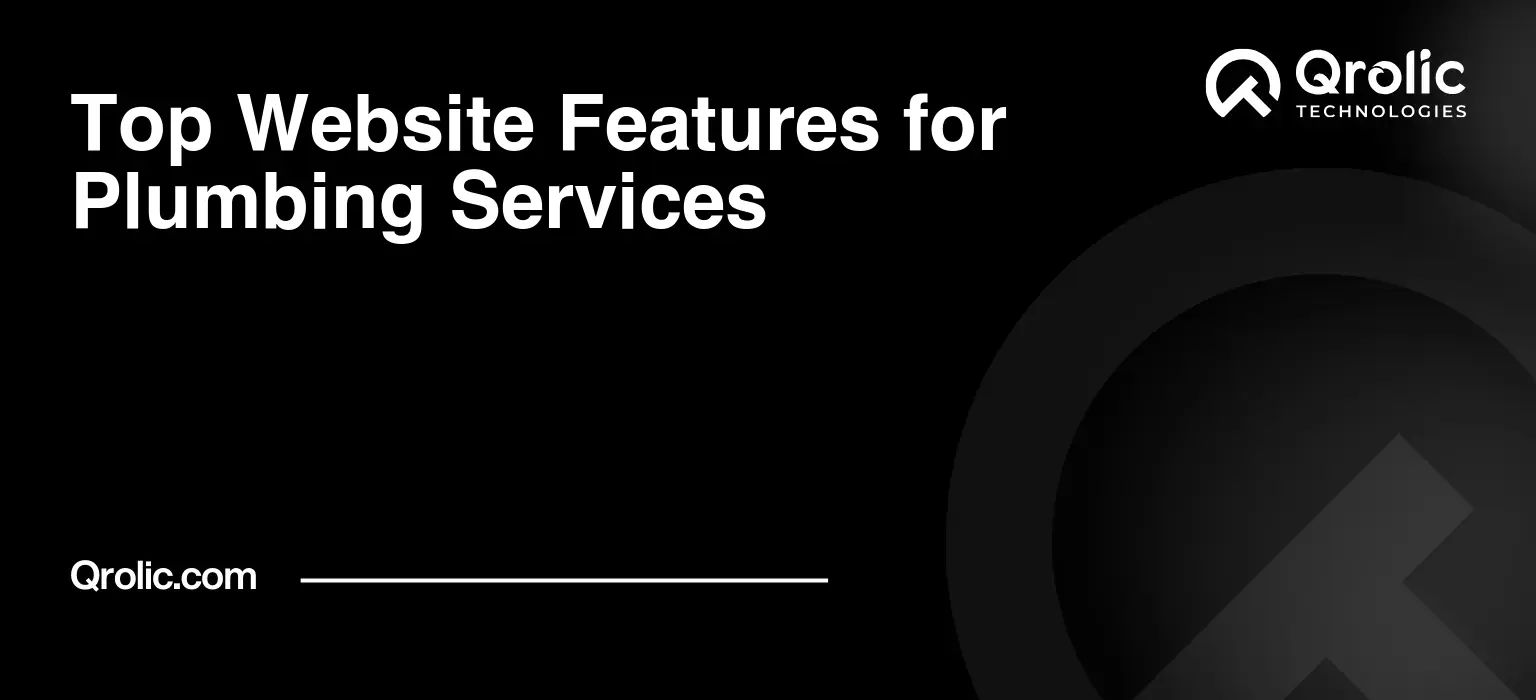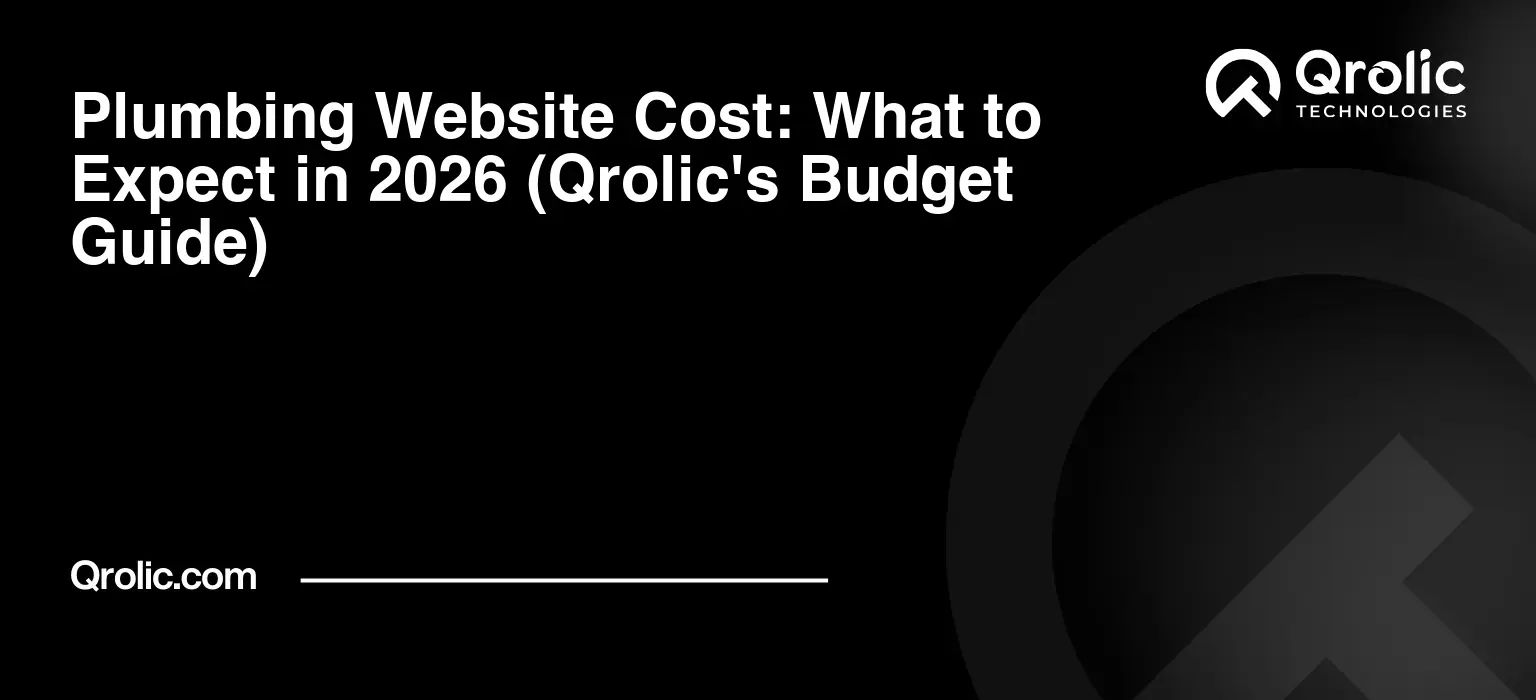Quick Summary:
- Ensure your plumbing website is mobile-friendly.
- Clearly list services, prices, and emergency contact.
- Offer easy online booking and showcase customer reviews.
- Build trust with an "About Us" page and visuals.
Table of Contents
- The Foundational Fortress: Essential Plumbing Website Features for Success
- 1. Mobile-First Design: Reaching Customers Where They Are
- 2. Prominent Emergency Contact Information: A Lifeline in Times of Crisis
- 3. Clear Service Listing and Descriptions: Showcasing Your Expertise
- 4. Online Service Booking and Scheduling: Convenience at Your Customers’ Fingertips
- 5. Customer Reviews and Testimonials: Building Trust and Credibility
- 6. “About Us” Page: Humanizing Your Brand
- 7. Pricing Information (Optional): Transparency and Customer Education
- 8. Blog and Educational Resources: Establishing Expertise and Driving Traffic
- 9. Service Area Locator: Ensuring You Serve Their Neighborhood
- 10. Secure Socket Layer (SSL) Certificate: Protecting Customer Data and Building Trust
- 11. Accessibility Compliance: Ensuring Inclusivity for All Users
- 12. Integration with Social Media Platforms: Expanding Your Reach and Engaging with Customers
- 13. High-Quality Visuals: Showcasing Your Work and Building Trust
- 14. Fast Loading Speed: Optimizing for Performance and User Experience
- 15. Clear Call to Actions (CTAs): Guiding Visitors Towards Conversion
- The Qrolic Advantage: Partnering for Digital Plumbing Success
- The Plumbing Website Checklist: Ensuring Comprehensive Coverage
The Foundational Fortress: Essential Plumbing Website Features for Success
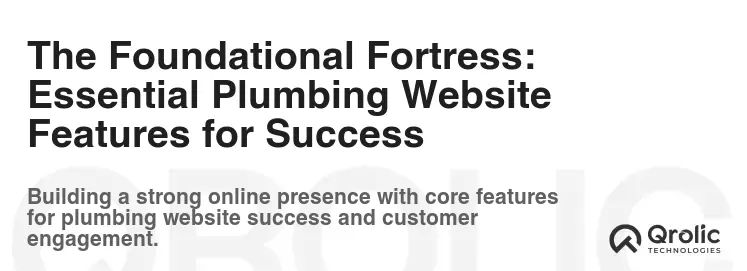
In today’s digital world, a plumbing service’s website is more than just an online brochure; it’s a 24/7 marketing engine, a customer service portal, and a lead generation machine. For potential customers facing a plumbing emergency or planning a home renovation, a well-designed website can be the deciding factor in choosing your business over the competition. But what truly separates a good plumbing website from a great one? It’s the thoughtful integration of features that address customer needs, build trust, and facilitate seamless interaction.
1. Mobile-First Design: Reaching Customers Where They Are
Why it Matters: In the age of smartphones, most online searches – especially those related to urgent services like plumbing – originate from mobile devices. A website that isn’t optimized for mobile is essentially invisible to a huge segment of your potential customer base. Google also prioritizes mobile-first indexing, meaning your website’s mobile version is the primary version used for ranking.
Key Considerations:
- Responsive Design: Ensure your website adapts seamlessly to different screen sizes, from smartphones to tablets to desktops.
- Fast Loading Speed: Mobile users are impatient. Optimize images, minimize code, and leverage browser caching to ensure quick loading times. Test your site speed using tools like Google PageSpeed Insights.
- Easy Navigation: Make it easy for mobile users to find what they need with a clear, concise menu and intuitive navigation.
- Click-to-Call Button: A prominent click-to-call button allows mobile users to instantly connect with your team in case of emergencies.
Example: Imagine a homeowner discovers a burst pipe late at night. They grab their phone and search for “emergency plumbing near me.” If your mobile website loads quickly, displays your phone number prominently, and allows them to call with a single tap, you’ve just gained a valuable lead.
2. Prominent Emergency Contact Information: A Lifeline in Times of Crisis
Why it Matters: When a pipe bursts, a toilet overflows, or a water heater malfunctions, time is of the essence. Customers need to be able to find your emergency contact information quickly and easily, regardless of the time of day or night. Hiding this information behind layers of menus or contact forms is a recipe for lost business.
Key Considerations:
- Above-the-Fold Placement: Display your emergency contact phone number prominently in the header or top navigation bar of every page on your website.
- Dedicated Emergency Page: Create a dedicated page outlining your emergency plumbing services, response times, and contact information.
- 24/7 Availability: If you offer 24/7 emergency service, make this abundantly clear on your website. Don’t bury this crucial detail.
- Live Chat (Optional): Consider implementing a live chat feature for immediate assistance during regular business hours. This can also be used to triage emergencies and gather initial information before dispatching a plumber.
Example: A website with a large, clickable phone number in the upper right corner, accompanied by the text “24/7 Emergency Plumbing Services,” immediately conveys trustworthiness and responsiveness.
3. Clear Service Listing and Descriptions: Showcasing Your Expertise
Why it Matters: Potential customers need to quickly understand the range of plumbing services you offer. Vague or incomplete service descriptions can leave them confused and send them searching elsewhere. Be specific, detailed, and use layman’s terms to explain what you do.
Key Considerations:
- Comprehensive Service List: Include a comprehensive list of all the plumbing services you provide, from drain cleaning and leak repair to water heater installation and sewer line replacement.
- Detailed Descriptions: Write clear, concise, and informative descriptions for each service, explaining what it entails, the benefits it provides, and any special equipment or techniques you use.
- Targeted Keywords: Use relevant keywords in your service descriptions to improve your website’s search engine rankings (e.g., “tankless water heater installation,” “hydro jetting drain cleaning,” “copper pipe repair”).
- Visual Aids: Use high-quality images and videos to illustrate your services and demonstrate your expertise.
Example: Instead of simply listing “Leak Repair,” provide a detailed description like: “Leak Repair: We locate and repair all types of plumbing leaks, including leaky faucets, burst pipes, toilet leaks, and slab leaks. Our experienced plumbers use advanced leak detection technology to minimize damage and ensure lasting repairs.”
4. Online Service Booking and Scheduling: Convenience at Your Customers’ Fingertips
Why it Matters: In today’s fast-paced world, customers expect convenience and flexibility. Offering online service booking allows them to schedule appointments at their own pace, without having to pick up the phone. This can significantly increase your lead generation and customer satisfaction.
Key Considerations:
- User-Friendly Interface: Design a simple and intuitive online booking system that is easy to navigate on both desktop and mobile devices.
- Real-Time Availability: Integrate your booking system with your scheduling software to display real-time availability and prevent double-booking.
- Service Selection: Allow customers to select the specific service they need from a predefined list.
- Date and Time Selection: Provide a calendar interface for customers to choose their preferred date and time.
- Automated Confirmation: Send automated email and SMS confirmations to customers upon booking, as well as reminders closer to the appointment date.
- Integration with Payment Gateway (Optional): Consider integrating with a payment gateway to allow customers to pre-pay for services online.
Example: A customer with a busy schedule can log onto your website at 11 PM, select “Drain Cleaning,” choose a convenient appointment time for the following week, and receive an immediate confirmation email. This eliminates the need for phone calls and back-and-forth communication.
5. Customer Reviews and Testimonials: Building Trust and Credibility
Why it Matters: Online reviews and testimonials are powerful social proof that can significantly influence a potential customer’s decision. Positive reviews demonstrate your commitment to quality workmanship and customer satisfaction, while negative reviews provide valuable feedback for improvement.
Key Considerations:
- Display Reviews Prominently: Showcase positive reviews and testimonials on your homepage, service pages, and throughout your website.
- Encourage Reviews: Actively solicit reviews from satisfied customers through email, SMS, or online review platforms like Google My Business, Yelp, and Facebook.
- Respond to Reviews: Respond to both positive and negative reviews in a timely and professional manner. Acknowledge concerns, offer solutions, and demonstrate your commitment to customer satisfaction.
- Utilize Review Snippets: Implement schema markup to display star ratings and review snippets in search engine results, increasing your website’s click-through rate.
Example: A homeowner researching plumbing services online is more likely to choose a company with a 4.8-star rating and dozens of positive reviews than a company with no reviews or a lower rating.
6. “About Us” Page: Humanizing Your Brand
Why it Matters: The “About Us” page is your opportunity to tell your story, showcase your company’s values, and build a personal connection with potential customers. It’s a chance to demonstrate your expertise, experience, and commitment to serving your community.
Key Considerations:
- Company History: Share your company’s history, milestones, and values.
- Team Bios: Introduce your team members, highlighting their qualifications, experience, and expertise. Include photos to personalize the page.
- Mission Statement: Clearly articulate your company’s mission statement and what you stand for.
- Community Involvement: Showcase your involvement in local community events and charitable initiatives.
- Professional Affiliations: Highlight your membership in professional organizations and certifications.
Example: A plumbing company’s “About Us” page might feature a photo of the owner with his family, a brief history of how the company was founded, and testimonials from satisfied customers praising their professionalism and integrity.
7. Pricing Information (Optional): Transparency and Customer Education
Why it Matters: While providing exact pricing online can be challenging due to the variability of plumbing jobs, offering some level of pricing transparency can build trust and attract price-conscious customers.
Key Considerations:
- Price Ranges: Provide price ranges for common services to give customers a general idea of the potential cost.
- Flat-Rate Pricing: Offer flat-rate pricing for specific services, such as drain cleaning or toilet repair.
- Online Quotes: Implement an online quote request form that allows customers to provide details about their project and receive a customized estimate.
- “Starting At” Pricing: Use “starting at” pricing to indicate the base price for a service, with a disclaimer that the final price may vary depending on the specific circumstances.
Example: A plumbing website might list “Drain Cleaning: Starting at $99” and “Water Heater Installation: Starting at $599 (includes standard unit).”
8. Blog and Educational Resources: Establishing Expertise and Driving Traffic
Why it Matters: Creating a blog and publishing informative articles about plumbing-related topics can establish your company as a trusted authority in the industry, attract organic traffic to your website, and educate potential customers about common plumbing issues and solutions.
Key Considerations:
- Relevant Topics: Choose blog topics that are relevant to your target audience, such as “How to Prevent Frozen Pipes,” “Signs You Need a New Water Heater,” or “DIY Plumbing Tips.”
- Informative Content: Write informative, engaging, and easy-to-understand articles that provide valuable information to readers.
- Keyword Optimization: Optimize your blog posts for relevant keywords to improve their search engine rankings.
- Visual Content: Include images, videos, and infographics to enhance the visual appeal of your blog posts and make them more engaging.
- Call to Action: Include a clear call to action at the end of each blog post, encouraging readers to contact you for service or request a quote.
Example: A blog post titled “5 Signs Your Toilet Needs Repair” could educate readers about common toilet problems, provide DIY troubleshooting tips, and encourage them to contact the company for professional repair services.
9. Service Area Locator: Ensuring You Serve Their Neighborhood
Why it Matters: Customers need to know if you service their area. A service area locator clearly defines the geographical regions where you provide plumbing services, preventing frustration and ensuring that you’re targeting the right audience.
Key Considerations:
- Interactive Map: Integrate an interactive map that displays your service area.
- List of Cities and Towns: Provide a list of all the cities and towns you serve.
- Zip Code Lookup: Allow customers to enter their zip code to quickly determine if they are within your service area.
Example: A website with a map highlighting the counties it serves, along with a list of cities like “Anytown,” “Bakersville,” and “Carlisle,” makes it easy for potential customers to determine if they’re within the service area.
10. Secure Socket Layer (SSL) Certificate: Protecting Customer Data and Building Trust
Why it Matters: An SSL certificate encrypts the data transmitted between your website and your visitors’ browsers, protecting sensitive information such as contact details, payment information, and login credentials. An SSL certificate is essential for building trust with customers and complying with data privacy regulations.
Key Considerations:
- HTTPS Protocol: Ensure your website uses the HTTPS protocol, which indicates that it is secured with an SSL certificate.
- Padlock Icon: Look for the padlock icon in the browser’s address bar, which indicates that the connection is secure.
- Certificate Validation: Verify that your SSL certificate is valid and up-to-date.
Example: A website with a padlock icon in the address bar and a URL that begins with “https://” signals to visitors that their information is being transmitted securely.
11. Accessibility Compliance: Ensuring Inclusivity for All Users
Why it Matters: Website accessibility ensures that your website is usable by people with disabilities, including those with visual impairments, hearing impairments, motor impairments, and cognitive impairments. Accessibility compliance is not only a legal requirement in some jurisdictions but also a moral imperative.
Key Considerations:
- Web Content Accessibility Guidelines (WCAG): Follow the Web Content Accessibility Guidelines (WCAG) to ensure your website is accessible.
- Alternative Text for Images: Provide alternative text descriptions for all images to make them accessible to users with visual impairments.
- Keyboard Navigation: Ensure that your website can be navigated using a keyboard alone.
- Sufficient Color Contrast: Use sufficient color contrast between text and background to make your website readable for users with visual impairments.
- Captioning and Transcripts for Videos: Provide captions and transcripts for all videos to make them accessible to users with hearing impairments.
Example: A website that provides alternative text for images, uses clear and concise language, and allows users to navigate using a keyboard is more accessible to people with disabilities.
12. Integration with Social Media Platforms: Expanding Your Reach and Engaging with Customers
Why it Matters: Integrating your website with social media platforms allows you to expand your reach, engage with customers, and build brand awareness.
Key Considerations:
- Social Media Sharing Buttons: Add social media sharing buttons to your blog posts and service pages to make it easy for visitors to share your content on their social media accounts.
- Social Media Feeds: Embed your social media feeds on your website to display your latest posts and updates.
- Social Media Login: Allow users to log in to your website using their social media accounts.
Example: A plumbing company that shares helpful plumbing tips on its Facebook page and encourages customers to leave reviews on its Yelp profile can build a strong online presence and attract new customers.
13. High-Quality Visuals: Showcasing Your Work and Building Trust
Why it Matters: High-quality visuals, including photos and videos, can significantly enhance the appeal of your website and build trust with potential customers.
Key Considerations:
- Professional Photography: Use professional photography to showcase your work and highlight the quality of your services.
- Before and After Photos: Display before and after photos of your plumbing projects to demonstrate the effectiveness of your services.
- Video Testimonials: Include video testimonials from satisfied customers to build trust and credibility.
- Branded Graphics: Use branded graphics and visual elements to create a cohesive and professional look and feel for your website.
Example: A plumbing company that displays high-quality photos of its plumbers working on various projects, along with before and after photos of completed jobs, can create a positive impression and build trust with potential customers.
14. Fast Loading Speed: Optimizing for Performance and User Experience
Why it Matters: Website loading speed is a critical factor that affects user experience, search engine rankings, and conversion rates. slow-loading websites can frustrate visitors and lead to high bounce rates.
Key Considerations:
- Optimize Images: Compress images to reduce file size without sacrificing quality.
- Minimize HTTP Requests: Reduce the number of HTTP requests by combining CSS and JavaScript files, using CSS sprites, and leveraging browser caching.
- Enable Browser Caching: Enable browser caching to allow visitors’ browsers to store static assets, such as images and CSS files, so they don’t have to be downloaded every time they visit your website.
- Use a Content Delivery Network (CDN): Use a CDN to distribute your website’s content across multiple servers around the world, reducing latency and improving loading speed for users in different geographical locations.
- Choose a Fast Hosting Provider: Choose a reliable and fast hosting provider that can deliver your website’s content quickly and efficiently.
Example: A website that loads in under three seconds provides a positive user experience and is more likely to rank higher in search engine results.
15. Clear Call to Actions (CTAs): Guiding Visitors Towards Conversion
Why it Matters: Clear call to actions (CTAs) guide visitors towards conversion by telling them exactly what you want them to do, whether it’s requesting a quote, scheduling an appointment, or contacting you for service.
Key Considerations:
- Prominent Placement: Place CTAs prominently on your website, such as in the header, footer, and within your content.
- Action-Oriented Language: Use action-oriented language that encourages visitors to take action, such as “Request a Quote,” “Schedule an Appointment,” or “Contact Us Today.”
- Visual Appeal: Make your CTAs visually appealing by using contrasting colors, bold fonts, and eye-catching graphics.
- Mobile-Friendly Design: Ensure that your CTAs are easily clickable on mobile devices.
Example: A website with a large, brightly colored button that says “Get a Free Quote” immediately grabs the visitor’s attention and encourages them to take the next step.
The Qrolic Advantage: Partnering for Digital Plumbing Success
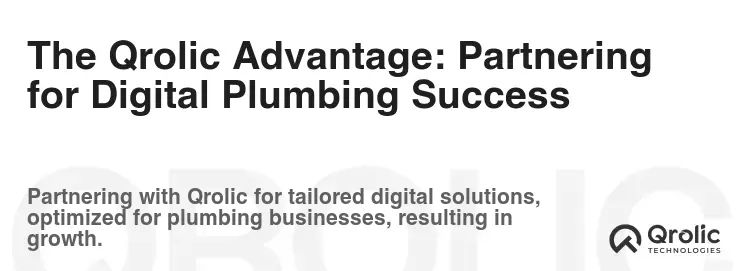
Now that you understand the essential features of a successful plumbing website, you might be wondering how to implement them effectively. That’s where Qrolic Technologies comes in.
Qrolic Technologies is a full-service digital marketing agency specializing in helping businesses like yours thrive online. We offer a comprehensive suite of services, including:
- Website Design and Development: We create custom, mobile-first websites that are optimized for performance, user experience, and search engine rankings.
- Search Engine Optimization (SEO): We help you improve your website’s visibility in search engine results, driving more organic traffic to your site.
- Pay-Per-Click (PPC) Advertising: We manage your PPC campaigns on Google Ads and other platforms to generate targeted leads and increase conversions.
- Social Media Marketing: We help you build your brand presence on social media, engage with customers, and drive traffic to your website.
- Content Marketing: We create high-quality content that attracts and engages your target audience, establishing you as a trusted authority in the plumbing industry.
By partnering with Qrolic Technologies, you can focus on what you do best – providing exceptional plumbing services – while we handle the complexities of your digital marketing strategy. We’ll work closely with you to understand your business goals and develop a customized plan that delivers measurable results.
The Plumbing Website Checklist: Ensuring Comprehensive Coverage
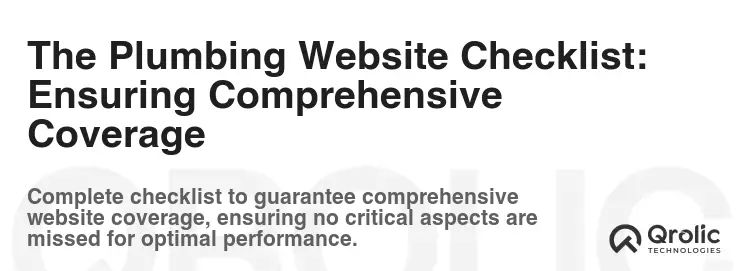
To ensure your plumbing website is fully optimized for success, use this comprehensive checklist:
- [ ] Mobile-First Design
- [ ] Prominent Emergency Contact Information
- [ ] Clear Service Listing and Descriptions
- [ ] Online Service Booking and Scheduling
- [ ] Customer Reviews and Testimonials
- [ ] “About Us” Page
- [ ] Pricing Information (Optional)
- [ ] Blog and Educational Resources
- [ ] Service Area Locator
- [ ] Secure Socket Layer (SSL) Certificate
- [ ] Accessibility Compliance
- [ ] Integration with Social Media Platforms
- [ ] High-Quality Visuals
- [ ] Fast Loading Speed
- [ ] Clear Call to Actions (CTAs)
By implementing these features and partnering with a trusted digital marketing agency like Qrolic Technologies, you can create a plumbing website that attracts new customers, builds brand loyalty, and drives sustainable business growth. The digital landscape is ever evolving, but by focusing on these foundational elements, you’ll be well-positioned to succeed in the competitive plumbing market for years to come. Don’t let your online presence be a leaky faucet, make it a powerful and efficient tool for success!
